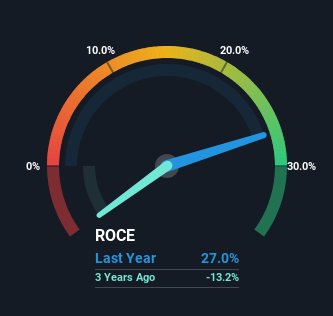There are a few key trends to look for if we want to identify the next multi-bagger. Typically, we'll want to notice a trend of growing return on capital employed (ROCE) and alongside that, an expanding base of capital employed. Basically this means that a company has profitable initiatives that it can continue to reinvest in, which is a trait of a compounding machine. And in light of that, the trends we're seeing at IVP's (NSE:IVP) look very promising so lets take a look.
What Is Return On Capital Employed (ROCE)?
If you haven't worked with ROCE before, it measures the 'return' (pre-tax profit) a company generates from capital employed in its business. Analysts use this formula to calculate it for IVP:
Return on Capital Employed = Earnings Before Interest and Tax (EBIT) ÷ (Total Assets - Current Liabilities)
0.27 = ₹333m ÷ (₹3.8b - ₹2.6b) (Based on the trailing twelve months to June 2023).
Thus, IVP has an ROCE of 27%. That's a fantastic return and not only that, it outpaces the average of 14% earned by companies in a similar industry.
Check out our latest analysis for IVP

Historical performance is a great place to start when researching a stock so above you can see the gauge for IVP's ROCE against it's prior returns. If you'd like to look at how IVP has performed in the past in other metrics, you can view this free graph of past earnings, revenue and cash flow.
How Are Returns Trending?
The trends we've noticed at IVP are quite reassuring. The numbers show that in the last five years, the returns generated on capital employed have grown considerably to 27%. The company is effectively making more money per dollar of capital used, and it's worth noting that the amount of capital has increased too, by 46%. So we're very much inspired by what we're seeing at IVP thanks to its ability to profitably reinvest capital.
Another thing to note, IVP has a high ratio of current liabilities to total assets of 68%. This effectively means that suppliers (or short-term creditors) are funding a large portion of the business, so just be aware that this can introduce some elements of risk. While it's not necessarily a bad thing, it can be beneficial if this ratio is lower.
Our Take On IVP's ROCE
To sum it up, IVP has proven it can reinvest in the business and generate higher returns on that capital employed, which is terrific. Investors may not be impressed by the favorable underlying trends yet because over the last five years the stock has only returned 28% to shareholders. So with that in mind, we think the stock deserves further research.
IVP does come with some risks though, we found 4 warning signs in our investment analysis, and 1 of those makes us a bit uncomfortable...
High returns are a key ingredient to strong performance, so check out our free list ofstocks earning high returns on equity with solid balance sheets.
New: AI Stock Screener & Alerts
Our new AI Stock Screener scans the market every day to uncover opportunities.
• Dividend Powerhouses (3%+ Yield)
• Undervalued Small Caps with Insider Buying
• High growth Tech and AI Companies
Or build your own from over 50 metrics.
Have feedback on this article? Concerned about the content? Get in touch with us directly. Alternatively, email editorial-team (at) simplywallst.com.
This article by Simply Wall St is general in nature. We provide commentary based on historical data and analyst forecasts only using an unbiased methodology and our articles are not intended to be financial advice. It does not constitute a recommendation to buy or sell any stock, and does not take account of your objectives, or your financial situation. We aim to bring you long-term focused analysis driven by fundamental data. Note that our analysis may not factor in the latest price-sensitive company announcements or qualitative material. Simply Wall St has no position in any stocks mentioned.
About NSEI:IVP
Slight risk with mediocre balance sheet.
Similar Companies
Market Insights
Community Narratives



